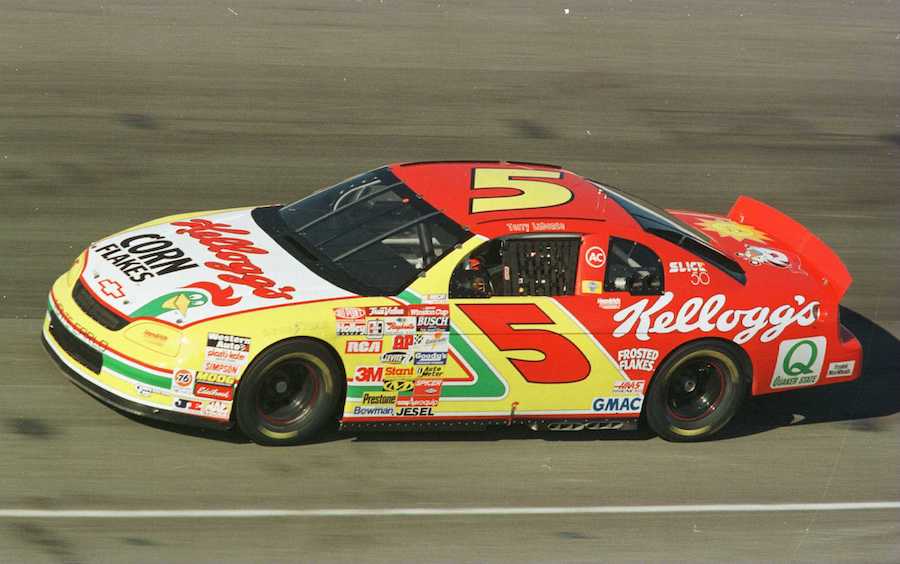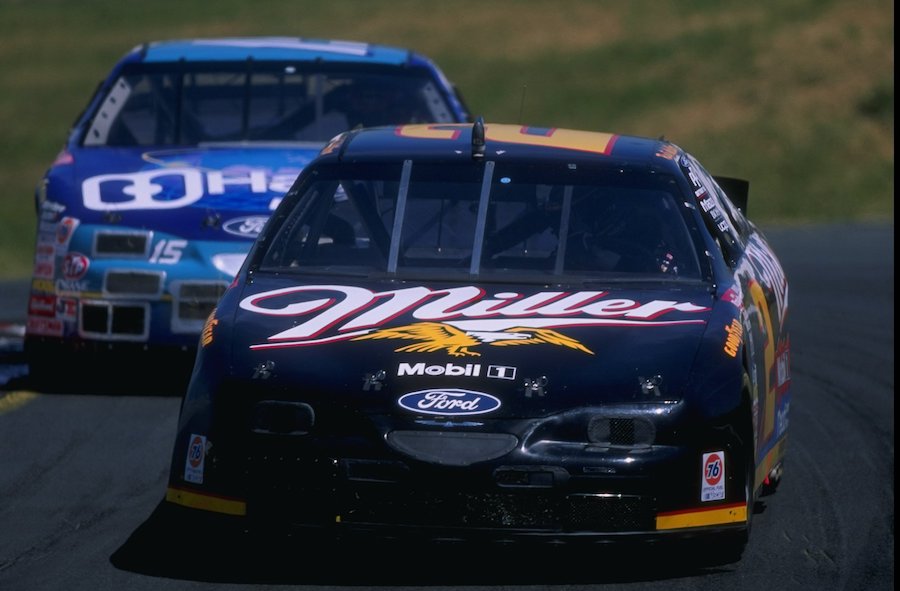As teams, drivers and fans entered Daytona Int’l Speedway to start the 1990 NASCAR Cup Series season, Dale Earnhardt had another chance to record an elusive Daytona 500 victory.
However, Earnhardt struck a piece of metal from a broken bell housing while leading with less than half a lap remaining. It cut the right-rear tire on his No. 3 Richard Childress Racing Chevy, handing the victory to Derrike Cope of Spanaway, Wash.
It was Cope’s first victory in 71 starts. He won again at Dover (Del.) Motor Speedway later in the year, but those were the only victories of his career.
Earnhardt captured his third Cup Series championship that season and eventually added titles in 1991, ’93 and ’94.
After securing his seventh championship on Oct. 23, 1994, at Rockingham (N.C.) Speedway, the driver from Kannapolis, N.C., simply said, “It’s great to be No. 1 all the way around on race day. I drive a race car 100 percent-plus every race. And that’s what I intend to do until I retire.”
On Oct. 20, 1990, USAC open-wheel star Jeff Gordon made his first NASCAR Xfinity Series start at Rockingham, driving an Oldsmobile for team owner Hugh Connerty. The native of Vallejo, Calif., then drove a Ford owned by Bill Davis for two full Xfinity Series seasons before signing with Hendrick Motorsports.
Goron made his NASCAR Cup Series debut at Atlanta Motor Speedway on Nov. 15, 1992, and the driver of the No. 24 Hendrick Motorsports Chevrolet posted his first series victory in the Coca-Cola 600 on May 29, 1994, at Charlotte Motor Speedway.
Gordon collected the most wins in the Cup Series during the 1990s with 49. He also captured Cup Series titles in 1995, ’97 and ’98, racing in seven full-time seasons during the decade. He won a fourth Cup Series championship in 2001.
There was one track that helped build Gordon’s confidence after he mastered it.
“It wasn’t until we did a test when I got to Hendrick Motorsports that I was able to go to Martinsville (Va.) Speedway and make laps and try all kinds of things,” Gordon recalled. (Crew chief) Ray Evernham was trying to do things to the setups of the car that weren’t working, and nothing changed. I realized I had to change what I was doing. As I found something making all those laps, it started to click, and it did throughout the rest of my career. It was such a pleasure to go to Martinsville from then on.
“No matter what the rules were, the car, the tires, my age, it seemed like that was the one place I could go where I could consistently run up front and be a threat to win. When I looked at the number of wins I had (nine wins at Martinsville) and what that meant to Hendrick Motorsports and the end of my career, I don’t think there was a better track to win my final race (Nov. 1, 2015.)”
Gordon won 93 Cup Series races during his 25-year career.
The deaths of rising stars Davey Allison and Alan Kulwicki in 1993 rocked the NASCAR community.
Kulwicki, the reigning Cup Series champion, had earned his lone title in a very close battle with Bill Elliott at Atlanta Motor Speedway on Nov. 15, 1992, driving his own No. 7 AK Racing Ford.
The 38-year-old Wisconsin native died along with three others on April 1, 1993, when their private twin-engine plane crashed while on approach to Tri-Cities Regional Airport in Blountville, Tenn.

Allison, who grew up in Hueytown, Ala., arrived in the Cup Series on July 28, 1985. He finished 10th in his debut, driving for Hoss Ellington at Talladega (Ala.) Superspeedway.
Bobby Allison’s oldest son claimed 15 of his 19 victories during the 1990s with four coming from 1987 through 1989 for team owner Harry Ranier and 15 with Robert Yates, including the 1992 Daytona 500.
Allison died on July 13, 1993, from injuries suffered the previous day when the helicopter he was piloting crashed in the infield at Talladega Superspeedway. He was 32 years old.
Ernie Irvan made his mark with Morgan McClure Racing during the early 1990s, winning the 1991 Daytona 500 and six other Cup Series races. He was selected to replace Allison with Yates Racing and scored another eight victories.
Irvan nearly died of injuries suffered in a crash at Michigan Int’l Speedway on Aug. 20, 1994, but recovered to win three races in 1995 and two more in ’96. Irvan’s 15th and final Cup Series victory came at Michigan on June 15, 1997.
The native of Salinas, Calif., retired from driving in September 1999 following another hard crash at Michigan earlier that year.
Earnhardt matched Richard Petty when he secured his seventh championship in 1994.
Andy Petree, currently executive vice president of competition at RCR, was Earnhardt’s crew chief when he won his sixth and seventh Cup Series crowns.
“When we won the 1993 Cup championship, we were on top of the world and felt we could come back and win it again in 1994, which was the seventh championship for him,” Petree said. “Earnhardt didn’t show emotion all that much but I know it meant a great deal to him to be mentioned in the same sentence with Richard Petty as being the only two seven-time champions at that time. I know that meant a great deal to him.”
Gordon collected his first title with Hendrick Motorsports in 1995 while teammate Terry Labonte, of Corpus Christi, Texas, earned his second championship in 1996. Labonte is known for having the longest span between titles after claiming his first with car owner Billy Hagan in 1984.
“When I first walked into Hendrick Motorsports in late 1993, I knew I could win championships there,” Labonte said. “Hendrick was and still is an amazing place. It took 12 years to get the second championship. I enjoyed every year I was there (1994 through 2006). The first championship in 1984 meant everything to me, but I appreciated the second one even more because I realized just how tough it was to win it.
“People have asked me if I would do anything different and I say, ‘No. I wouldn’t change a thing.’ I can honestly say I had a great career.”
Labonte’s younger brother, Bobby, logged 12 victories for Joe Gibbs Racing during the 1990s. His first Cup Series triumph came in the 1995 Coca-Cola 600. He was also the winner at Atlanta in November 1996 when Terry Labonte claimed his second title.
Bobby Labonte finished second in the Cup Series points in 1999 and stepped to the top of the podium the following season.
Mark Martin, of Batesville, Ark., won 30 of his 40 Cup Series races for Roush Racing, and he finished second in the standings five times.
Interestingly, Rusty Wallace was the only driver to win at least one race every year during the decade of the 1990s. The racer from Arnold, Mo., celebrated two wins in 1990, his final season with drag racer Raymond Beadle’s Blue Max Racing, before driving Pontiacs and Fords for team owner Roger Penske.

Wallace won 10 races in 1993 and eight more the following season. He scored 55 Cup Series victories during his career.
“We had such great years together, first with Blue Max Racing and then with Roger,” Wallace said. “Those were some great years together. I enjoyed some of my best seasons in the 1990s, especially in 1993 and 1994. Then, we won five races in 1996. We just kept on winning everywhere we went. We had everything hooked up. Driving for Roger was great and being a part owner of the team was great.”
Dale Jarrett, driver of the No. 88 Robert Yates Racing Ford, closed the decade by winning his only Cup Series championship. The Hickory, N.C., native won 22 races during the 1990s and also logged 159 top-10 finishes during the decade. His biggest victories were the 1994 Daytona 500 and the 1999 Brickyard 400 at Indianapolis Motor Speedway.
The son of two-time Cup Series champion Ned Jarrett retired from driving in 2008 and followed his father into radio and television broadcasting.
“A lot of people might look at the Jarrett name and say I had an easy way in,” Jarrett said. “There were struggles but I knew hard work, effort and determination could take me anywhere you want to go. That’s what I’m proud of. Nothing along the way was given to me.
“Certainly, the name helped open some doors, but I worked hard to get to where I was. I think I helped leave the sport in a better place than when I arrived and helped it move forward. That’s something that’s very rewarding to me.”
NASCAR’s popularity skyrocketed to new heights during the 1990s with the addition of the annual Brickyard 400 at Indianapolis Motor Speedway a contributing factor.
The Cup Series cars first raced at the iconic 2.5-mile rectangular track on Saturday, May 6, 1994. Jeff Gordon beat Brett Bodine to the checkered flag by .53 seconds in front of a crowd estimated at more than 250,000.
The event purse topped $3.2 million and a NASCAR record 86 cars were entered.
THIS ARTICLE IS REPOSTED FROM THE MAY 29 EDITION OF SPEED SPORT INSIDER
SPEED SPORT Insider is the ad-free premium extension of SPEEDSPORT.com. Insider is dedicated to the best and brightest in motorsports journalism – created by the best writers, photographers and reporters in the business. From veteran Hall of Fame writers like Bones Bourcier, Dave Argabright, Pat Sullivan, Keith Waltz, Ralph Sheheen and Editor in Chief Mike Kerchner, to behind the scenes SPEED SPORT reporters like Grace Woelbing, David Hoffman and more.
By subscribing to Insider, you not only get exclusive access to this premium content, but you support the journalists that are vital to telling the stories that matter most. Subscriptions are just $5/mo or $44.95 for an entire year. View plans and details.

